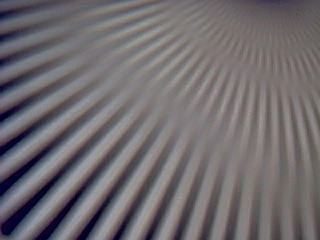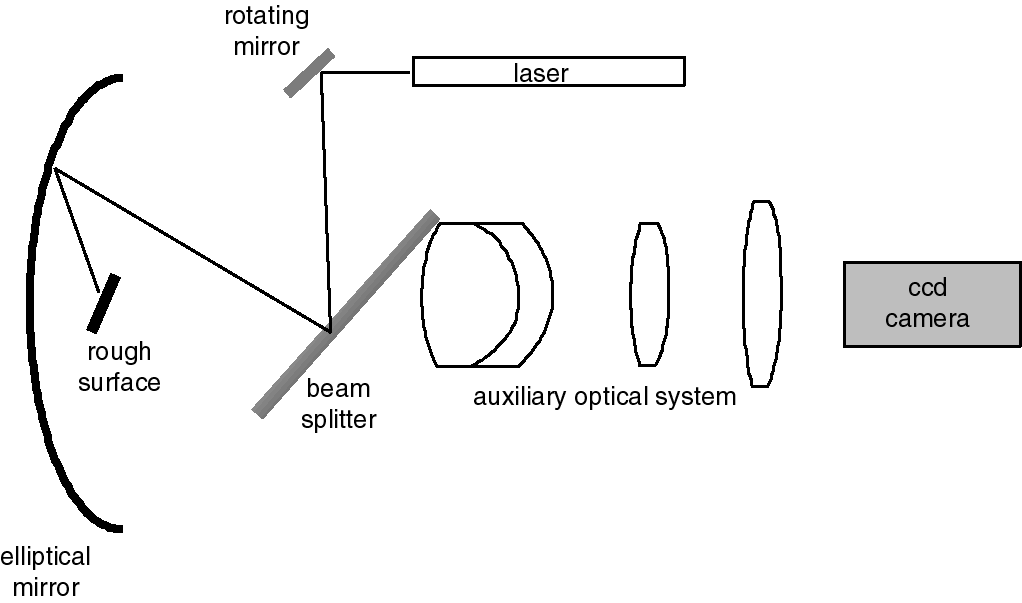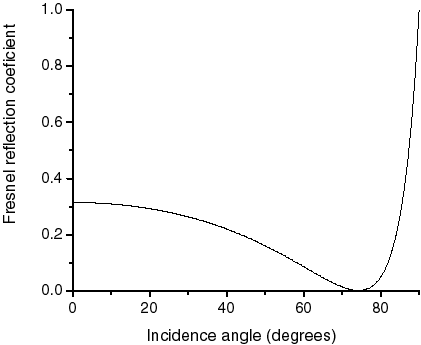
| Main Page |
|
Capacitance |
|
Polarization | Cursos |
 |
Neil C. Bruce | |||||
|
Scattering of light for characterisation of triangular groove surfaces
We have used the Kirchhoff approximation to characterise Indium Phosphide surfaces which are used as templates for growth of nanotubes.
In this work specimens were cut from semiconductor wafers commercially available from Atomergic Chemetals Corporation: N-type InP(100). Prior to the experiment, the specimens were cleaned by boiling in carbon tetrachloride and acetone, then rinsed in deionized water. For the formation of approximately parallel grooves oriented along the [011] direction the specimens were immersed in concentrated HCl (65%) at 20 oC for different lengths of time, then rinsed in deionized water. AFM images of an example of the prepared surfaces are shown below.
| Gray scale map of the surface | |
| 3D view of the surface | |
| 1D profile of the surface |
The profile function shown in the above figure was approximated as a triangular profile with all of the straight line segments having a gradient of ±m and the length of each segment given by a Gaussian random variable of average <x> and standard deviation s.
The Kirchhoff approximation applied to a perfectly conducting 1D surface gives the following equation for the scattered field
![]()
where ![]() and
and ![]() are the incident and scattered fields, respectively, H( ) is
the Hankel function,
are the incident and scattered fields, respectively, H( ) is
the Hankel function, ![]() is the scatter angle, and xand y are the horizontal
position and the surface height, respectively.
is the scatter angle, and xand y are the horizontal
position and the surface height, respectively.
The scatter pattern for light of wavelength of 632.8nm was measured with a scatterometer based on an eliptical mirror. A schematic diagram of the scatterometer is shown below.

The measured scattered light patterns were fitted to results obtained using the Kirchhoff approximation, and the values of the surface parameters required to obtain the best fit were compared to the values obtained from the AFM measurements. The graphs of the experimental measurements (for 20°, 40°, and 60° incidence)and the best fit Kirchhoff results are shown below.
 |
Continuous curve: Kirchhoff approximation Points: Experimental results |
The results for the surface parameters are given in the table below.
|
|
AFM data
|
Kirchhoff fit data |
|
m
|
0.23 ± 0.05
|
0.29 ± 0.03
|
|
<x> (mm)
|
0.69 ± 0.02
|
0.87 ± 0.03
|
|
s (mm)
|
0.20 ± 0.04
|
0.27 ± 0.03
|
From these results it can be seen that the values from the two methods agree within the error bars of the results. This shows that the model and the calculation method are correct.
It is interesting to analyze the effect of the assumption of a perfectly conducting surface to model the Indium Phosphate surfaces. In a perfectly conducting surface the reflection coefficient is constant for all the points on the surface, irrespective of the local incidence angle on the surface segments. The refractive index of Indium Phosphate at a wavelength of 633nm is n = 3.53 + i0.299 so that the energy reflection coefficient is as shown in the figure below.

From the value of the slope, m, given above, the angle between the surface and the mean plane is approximately 12.8°. This means that for normally incident light, the local angles of incidence are, depending on the orientation of the surface segment, ± 12.8°. Therefore, for this case the reflection coefficient is constant over the whole surface, and the perfectly conducting approximation should be very good for the relative scattered intensity distribution. The absolute scattered intensity distribution will be incorrect because the energy reflection coefficient is approximately 0.31 and not 1 as is assumed for a perfect conductor. However, here we are interested in the relative scattered intensity distribution so the approximation should be acceptable. If we have an incident angle of 40° between the incident beam and the normal to the mean plane, the local incidence angles are 52.8° and 27.2°, depending on the orientation of the surface segment. For these two angles the values of the energy reflection coefficients are 0.14 and 0.27, respectively. In this case we have a difference between the reflection coefficients for the different orientations of the surface segments. However, the surface segment with the larger angle of incidence is projected into a smaller size by the incidence angle and so the influence of this difference should be reduced, particularly as we are only considering the single scatter in this case. Indeed, as will be seen below, the agreement between the theory and experiment is very good for 40° incidence. It is expected that the phase differences introduced by the true refractive index, which are not included in the perfect conductor case, will make the approximation increasingly poor as the incidence angle increases above 40°.
Publication
| ICAT |